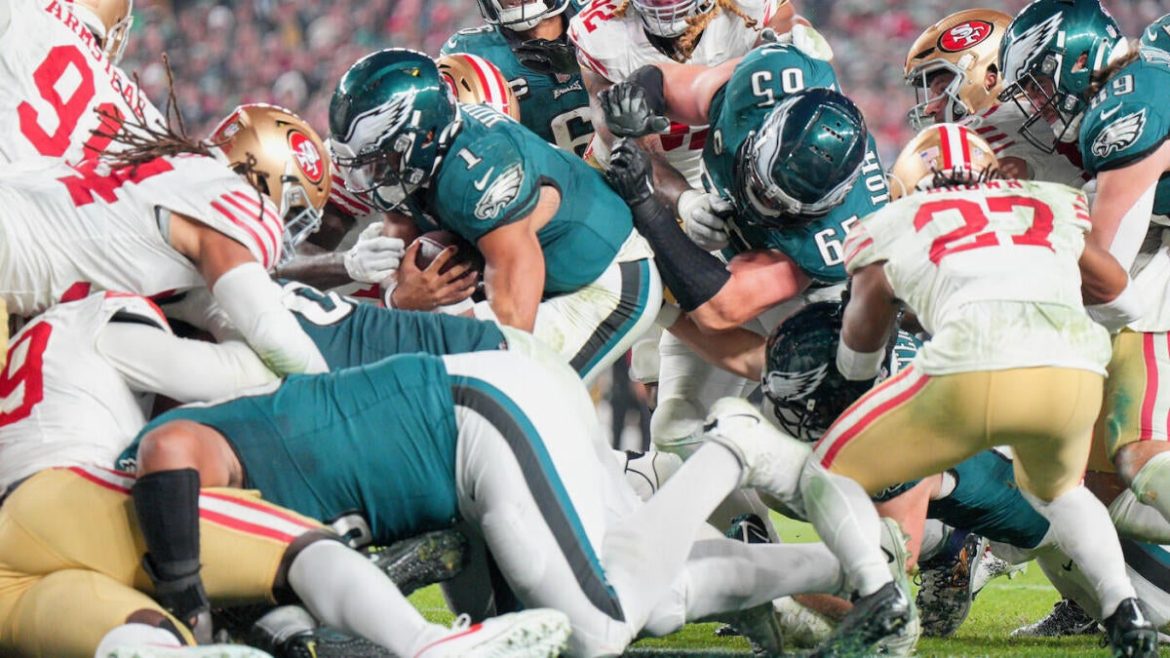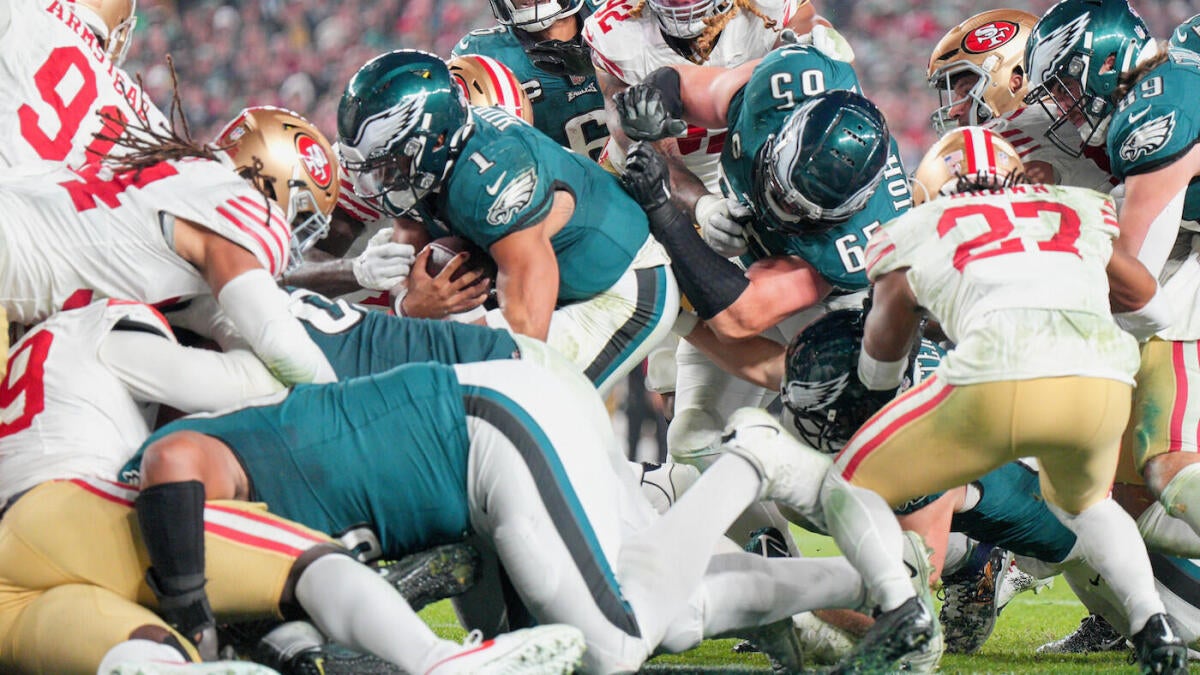The Battle Over the “Tush Push”: NFL’s Controversial Play and Its Future
The ongoing debate about the “tush push,” a quarterback sneak technique popularized and perfected by the Philadelphia Eagles, has captured the attention of the NFL, its teams, and fans alike. This play, involving teammates pushing the quarterback forward from behind to gain crucial short yardage, has been both lauded and lambasted, culminating most recently in a high-stakes league vote that narrowly failed to ban the tactic. The drama reveals much about team strategies, inter-team rivalries, and how the NFL navigates rule changes influenced by competitive advantages and safety concerns.
—
What is the “Tush Push” and Why Does It Matter?
Fundamentally, the “tush push” has become the Eagles’ signature weapon in short-yardage and goal-line situations. The play involves offensive linemen literally pushing quarterback Jalen Hurts, the 2025 Super Bowl MVP, forward from behind, helping him break through defensive lines when barely inches stand between a first down or touchdown.
Despite its simplicity, the play has revolutionized quarterback sneaks, delivering near-automatic success rates that frustrate opposing defenses. It’s enough to draw league-wide attention and even animosity, with some teams feeling it creates an unfair advantage that undermines defensive efforts and possibly raises player safety questions. Yet, the Eagles’ mastery of it underscores their overall dominance in recent seasons and their pursuit of back-to-back Super Bowl championships.
—
The Recent NFL Vote: A Narrow Defeat for the Ban
At the NFL owners’ spring meeting, a proposal led by the Green Bay Packers sought to ban the “tush push.” The league needed 24 out of 32 votes (75% approval) to enact the ban but fell short with only 22 votes in favor.
Who Voted For and Against?
– Against Ban (Voted to Keep “Tush Push”): Philadelphia Eagles, Baltimore Ravens, Cleveland Browns, Detroit Lions, Jacksonville Jaguars, Miami Dolphins, New England Patriots, New Orleans Saints, and at least two others formed the group opposing the ban.
– For Ban: A majority of teams voted to ban the play, including many of the Eagles’ NFC East rivals—Washington Commanders, Dallas Cowboys, and New York Giants—all of whom favored eliminating the “tush push.”
Notably, every team on the Eagles’ 2025 regular-season schedule except the Detroit Lions voted for the ban, signifying widespread concern among opponents about the play’s fairness and impact.
The Context of the Voting
In March, an earlier vote on the “tush push” also failed due to insufficient support. The spring meeting was seen as a potential turning point, as league sources noted this meeting often secures the votes the league office desires if earlier attempts falter. Despite this, the necessary threshold wasn’t crossed, underscoring how divisive the issue remains.
—
The Eagles’ Response and the Wider Implications
The Eagles’ reaction to surviving the vote reflects confidence but also caution. Commentators and insiders speculate that the play’s future in the NFL is still tenuous, as:
– The league can revisit the issue at future meetings, possibly with increased pressure for reform.
– Teams frustrated with the success of the “tush push” may intensify efforts to officially outlaw it.
– Player safety remains a debated justification, with critics labeling the push tactics as potentially hazardous, though the actual injury evidence is mixed.
The ego and strategic calculus behind the vote demonstrate that the NFL is as much a political battlefield as an athletic one. The Packers’ public support for the ban, despite having run a version of the sneak themselves in past seasons, hints at complex rivalries where teams leverage rule changes not solely for safety or fairness but strategic gain against contenders.
—
Division Rivalries and Strategic Fear
The voting pattern highlights a remarkable division: the Eagles stand almost isolated in their zone. None of their NFC East rivals voted to protect the “tush push,” suggesting a strategic effort to diminish the Eagles’ on-field advantage. Meanwhile, the Lions, a less direct rival, remain the only team scheduled to play the Eagles that has defended the play, further highlighting political alliances and oppositions formed through performance.
This division poses an intriguing narrative where:
– The Eagles face both tactical and political resistance to their favored play.
– NFC teams’ fears align closely against the Eagles, perhaps acknowledging the “tush push” as a blueprint for their recent success, and thus a target for elimination.
– Other teams that voted against the ban may see the play as a legitimate part of evolving NFL tactics, or simply prefer not to shift the status quo mid-competition.
—
The Play’s Role in the Eagles’ Super Bowl Run
The “tush push” was a defining factor in the Eagles’ 2025 campaign, notably showcased during their dominant 55-23 NFC Championship win over the Washington Commanders. The team employed the play multiple times, forcing officials to warn the Commanders for repeated infractions, underscoring how impactful the tactic is.
Despite making up only a small fraction (0.28%) of total plays league-wide, the “tush push” carries outsized influence in critical moments. Its continued presence stresses the Eagles’ preparation and innovation and marks them as a team always seeking the next edge for championship success.
—
Looking Forward: The Future of the “Tush Push” in the NFL
While the vote to ban the “tush push” failed, this is likely only a temporary reprieve. Several factors suggest the NFL will return to this issue repeatedly:
For now, teams can legally continue to deploy the “tush push” in upcoming seasons, but the ongoing dialogue means its ultimate fate remains uncertain. The Eagles, meanwhile, must prepare for both the play’s potential ban and continued scrutiny, perhaps innovating new tactics to maintain their competitive advantage.
—
Conclusion: Innovation Meets Resistance in the NFL’s Rulebook
The “tush push” saga encapsulates a classic sports narrative where innovation on the field meets resistance off it. The Eagles’ signature play has not only shaped the outcome of important games but also provoked a league-wide confrontation over fairness, safety, and tradition. The recent vote’s failure to ban the play by a narrow margin reveals a divided NFL grappling with how to regulate emerging strategies that tilt competitive balance.
As the battle lines remain drawn, the “tush push” serves as a symbol of the dynamic tension between evolving athletic ingenuity and the custodianship of the game’s rules. Fans and teams can expect this debate to continue, underscoring that in professional football, even a “simple push” can ignite complex, high-stakes drama.





